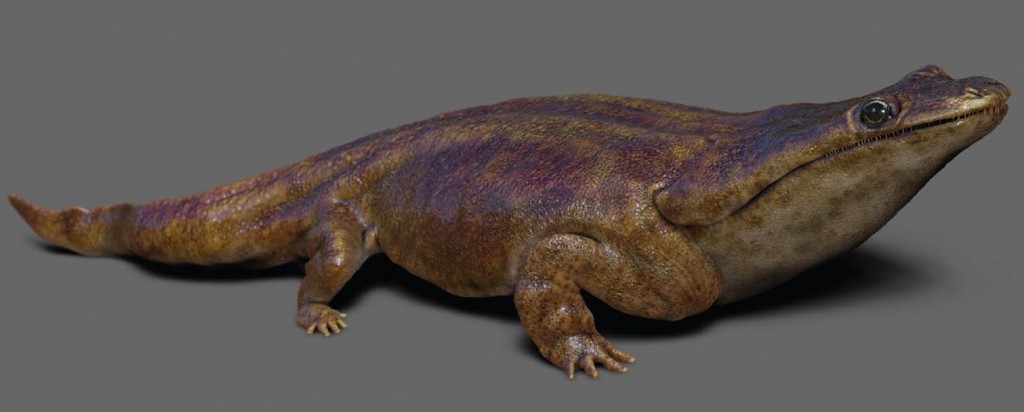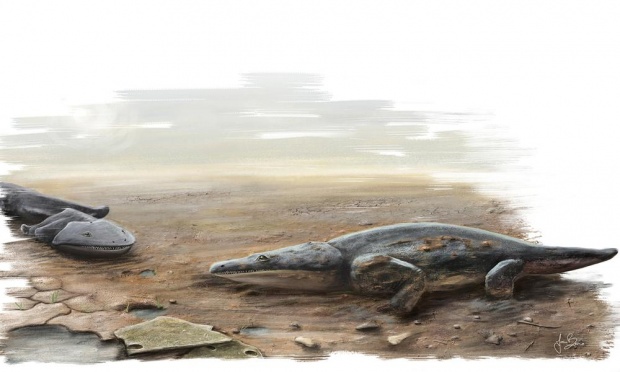 Researchers at the University of Edinburgh have identified a new species of carnivorous amphibian in the Algarve, which inhabited the Earth at the beginning of the Age of Dinosaurs, more than 200 million years ago. Bones of this new species, called Metoposaurus algarvensis, were found in rocks of an ancient lake in the region of Loulé.
Researchers at the University of Edinburgh have identified a new species of carnivorous amphibian in the Algarve, which inhabited the Earth at the beginning of the Age of Dinosaurs, more than 200 million years ago. Bones of this new species, called Metoposaurus algarvensis, were found in rocks of an ancient lake in the region of Loulé.
According to the British newspaper The Guardian, which the study cites, the animal, which would resemble a giant salamander, would have a size of 'a small car [two meters long in adulthood] and fed on fish that abounded in waterways at the end of the period. Triassic».
Although metoposaurs have been identified in other parts of the globe, researchers say they are a new species, due to "differences in the structure of the jaw and in parts of the skull where the spinal cord connects with the brain." The creature would have a long, flat head that Steve Brusatte, who led the study, compared to "a toilet seat with thousands of tiny teeth."
According to the paleentologist Luís Azevedo Rodrigues, from the Living Science Center of Lagos, in statements to Sul Informação, "O Metoposaurus algarvensis belongs to a group of animals called amphibians temnospondyles, with habits similar to those of current crocodiles – they were predators of river environments (rivers and lake environments). Despite being common in various parts of the globe in the Upper Triassic (237-201 million years), they are rare in the Iberian Peninsula».
The discovery of this new species is, for the paleontologist, «very important as it allows to better characterize this group of animals at an anatomical level, their kinship relationships in the Triassic “tree of life” and allows to characterize some of the ecosystems of that time, beyond of the environments in which he lived».
Although this metoposaurus is compared to a salamander, there is no relationship between the prehistoric animal and any current species, since «a great part of the temnospondyles disappeared in the mega-extinction of the Triassic-Jurassic (201 million years ago) with some metoposaurs survived this extinction”, but “all temnospondyles, of which metoposaurs are a part, became extinct in the lower Cretaceous (approximately 100 million years ago)”.
Luís Azevedo Rodrigues explains that «the rocks where these fossils were found were part of what is called the Algarve Basin, an area where large amounts of sediment would accumulate at a time in Earth's history when the Atlantic Ocean was beginning to open up. during the fragmentation of Pangea'.
Discoveries from the Triassic period in the Algarve are, however, nothing new. «During the 1970s and 1980s, a German geology student (Thomas Schroter) made several research excursions to Penina having collected fossils that were later taken to Germany, and are currently in the collections of the Museum of Nature of Berlin (Natural History Museum)” and “in 2008, two German authors, Witzmann and Gassner, had already described and published several fossils of Penina temnospondyles, having even placed in the publication a very detailed map of the discovery sites”, he says. Luís Azevedo Rodrigues.
The paleontologist made reference to this last year when he presented a lecture at the VIII Meeting of Geosciences Teachers of Alentejo and Algarve, in Silves, where he spoke about the extinction of the Triassic-Jurassic, referred to the paleontological research works, past and recent in Penina, and lamented “the deposit of vertebrate specimens outside the Algarve”.
In the place where the bones of this Metoposaurus algarvensis there may be, according to The Guardian, “hundreds of amphibians who died when an ancient lake dried up. So far only a fraction of the site has been excavated», and this team of researchers has already made field visits to the site twice.


















Comments